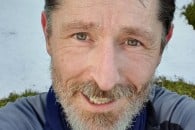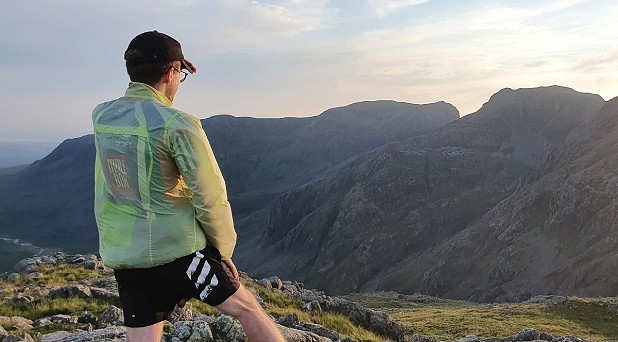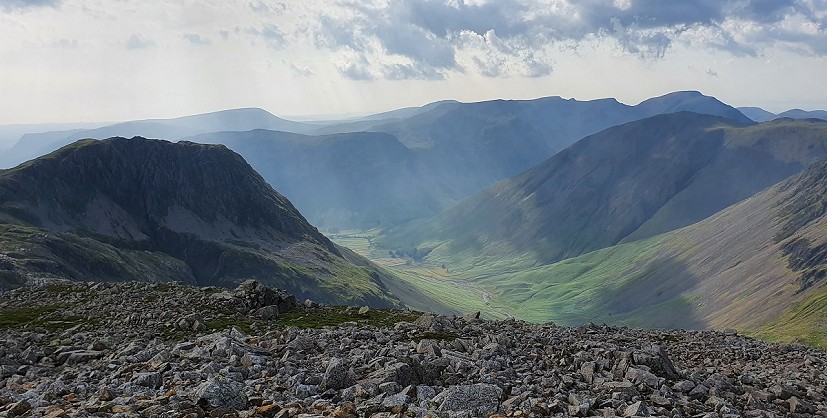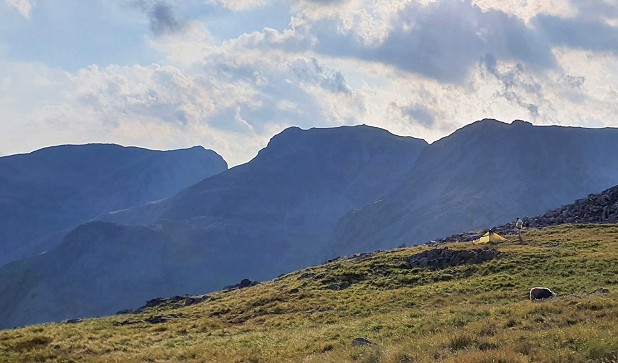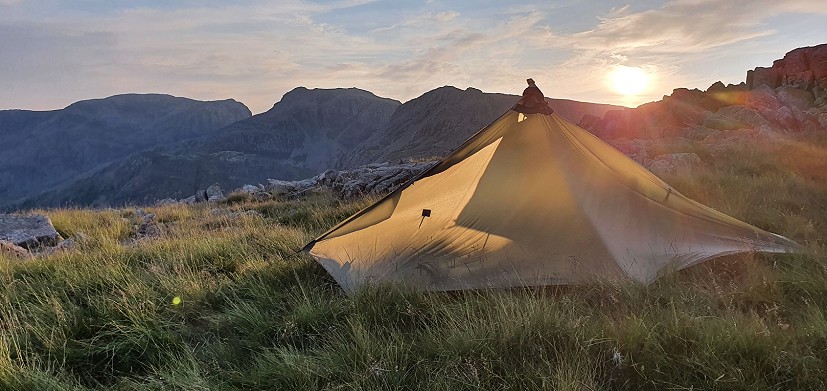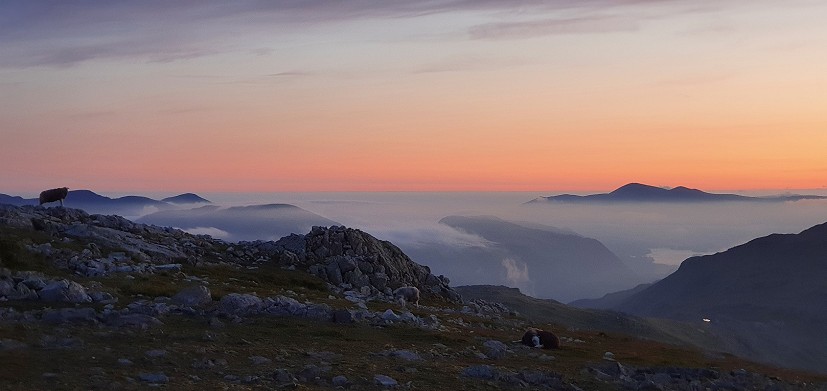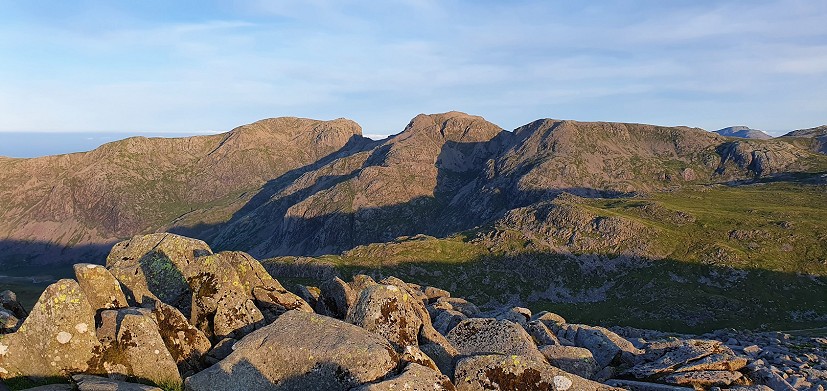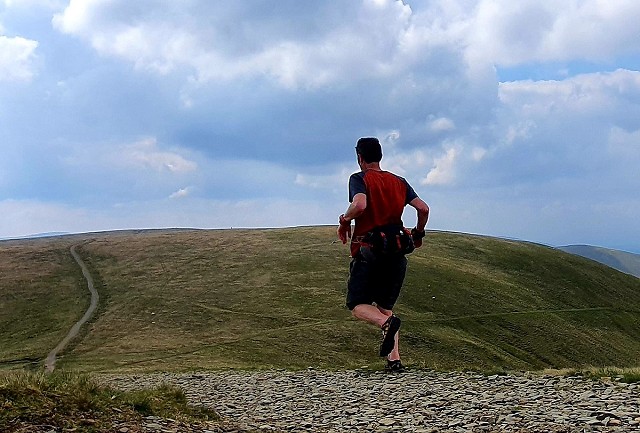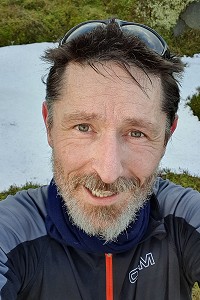Fastpacking - Without a Pack
Whether or not you're reconciled to the term 'fastpacking', there's an undeniable attraction to the ethos, which combines the light-footed pace of running with the freedom of overnight backpacking. But just how minimal can you go? Keen hill runner and backpacker Norman Hadley experiments with a bumbag-only approach.
As I pootled up Langdale in air-conditioned comfort, the dashboard told me it was twenty-eight degrees Celsius in the glare beyond the glass. For more senior readers, that's eighty-two in old money. Even the local lizards scuttled towards the Old Dungeon Ghyll panting and muttering something about umbrella-shades and Theakstons Best. By contrast, I was about to run up Lakeland's fifth, sixth and eleventh highest hills, carrying overnight gear, with a guy twenty-three years my junior.
As I pootled up Langdale in air-conditioned comfort, the dashboard told me it was twenty-eight degrees Celsius in the glare beyond the glass. For more senior readers, that's eighty-two in old money. Even the local lizards scuttled towards the Old Dungeon Ghyll panting and muttering something about umbrella-shades and Theakstons Best. By contrast, I was about to run up Lakeland's fifth, sixth and eleventh highest hills, carrying overnight gear, with a guy twenty-three years my junior.
Of course, I was looking forward to the prospect immensely. I'm not good with heat, having a tendency to wilt at anything over twenty-five degrees, but I have highly refined survival techniques, chief of which is a wet, pale buff around the head to shield my inconveniently thick and dark hair. I realise this may be galling to smoother-scalped readers but I am possibly the only middle-aged man in history to complain of having too much hair and too dark with it. In addition to head-covering, am I not above the tee-shirt-plunged-in-a-beck-and-put-back-on ploy. Whatever keeps heat stroke at bay is fine by me.
For now, it seemed sensible to hide in the cool of the car while waiting for Ed. The hay meadows on the valley floor had already acquired the toasted-malt tones of high summer. Redacre Gill was a dusty ribbon of dry rubble. The air looked so hot and still that Clint Eastwood could have ridden across the valley in the haze, chewing a cheroot.
Ed's arrival interrupted this flight of fancy. The plan was to run up onto Great End, before doubling back to Esk Pike to pitch our tents on a lovely off-shoot summit. I had scoped out some candidate pitches on previous runs and picked this spot as having the best view of the Scafells. While Ed carried his gear more conventionally stashed in a rucksack, I had my new ultralight fastpacking setup stuffed into my bumbag. This was the third outing for my no-rucksack setup after previous solo trips on the Patterdale and Wasdale fells.
You may think it eccentric to go fastpacking without a rucksack and, if you do, you won't be alone. This was a project that emerged as a thought-experiment in Covid lockdown and developed into a minor obsession. The kit had performed superbly on both prior trips so I felt reasonably confident it would hold up again, especially when the forecast was so favourable. All the same, this was the first trial in company so I felt a frisson of concern that something might let me down, with all the ignominy public failure brings.
We set off at a steady lope up the furnace of Mickleden. The only streams we could find were reduced to trickles. The bag felt comfortable and stable; many people expect a big bum bag to bounce uncontrollably but my experience is that it works fine if you get the weight evenly distributed around your hips with enough tension to hold it steady but not so much as to crush one innards. Running on the level was hot, if bearable, but the Stake Pass zigzags were significantly spicier. We backed off the pace for a while, up to the rocky turret of Rossett Pike. Langdale was a smouldering cauldron behind us but beyond the ridge lay the cool, tempting waters of Angle Tarn.
Wild swimming - not so much a fad as a necessity
Although the tarn was already busy with other swimmers, we were soon in and splashing about among them. Running in hot weather needn't be a gruelling business; we weren't aiming to break any Death Valley marathon records; we were out to have fun. The atmosphere was convivial and the collective need to keep cool engendered a sense of camaraderie.
Our freshly cooled blood and squelching socks propelled us up the rising path to Esk Hause and Great End. The views across the gulf of Styhead Pass to the screes of Great Gable were superlative. To the south lay the rocky spine of England, rising to Scafell Pike. We briefly considered an out-and-back to the Biggest Beast of All but decided it would undermine the easy-going feel of the run. So we dropped down from the Great End to fill our water bottles at the vital spring in Calf Cove, reduced to a languid dribble. Other thirsty pilgrims noticed us crouching in the grass and came to slake their own thirsts. For a moment, this trickle in the turf was as vital a social hub as any office water-cooler.
Pitching up
All that remained was a gentle trot over Esk Pike. We found an excellent pitch for two microtents gazing across to the huge Eskdale face of the Scafells and soon had shelters up with pans steaming. Ed was trialling his home-made meths burner, fashioned from a drinks can. Mine, more conventionally, was shop-bought. The two tents epitomised the trade-offs intrinsic to the ultralight style: Ed's was a ground-hugging, single-skin affair whereas mine was taller to allow for sitting up inside. This is what you need when you reach a certain creaky age but it comes at a cost of greater vulnerability to high winds. Happily, that wasn't going to be a problem on this trip. Most gratifyingly, both tents vanished into the landscape; when I took a photo from a minute's walk away, they were all but invisible. The evening passed cooking, brewing and yarning. Ed had to be away early in the morning so we crawled into our tents at a very un-rock'n'roll nine-thirty on a Friday night.
Six hours later, my body-clock decided it was time to surface. I could hardly blame it; the moon was full in the southern sky and, although the sun still had work to do to breach the horizon, there was already a rich apricot blush in the north-eastern sky. Ed was still in bed, so I went on a solo photographic walkabout, up to the summit of Esk Pike, across to Ore Gap and back via Pike de Bield. A partial inversion shrouded the fells to the north and east, with peach tones offset by aubergines and rusts. Langstrath Beck ribboned into the middle distance. The light found the top of Scafell Pike and slowly worked its way down, its shadowline defined by the ridge on which I stood.
Heading down
Ed surfaced at half past five. This was our first camping trip together and I discovered to my delight that he is not someone who faffs about. Breakfast and coffee were downed, tents stowed and we started running at six, bounding across dew-damp turf to Ore Gap and up to Bowfell's summit. The north-to-east panorama was superb, with morning light casting long shadows and ribbons of mist artfully draped over the hills. By now it was hot and layers were already being cast off. We dropped a little way down the Band, then swerved left for a gallop down the gentler, grassier contours of Green Tongue. These soon dropped us back into Mickleden for a refreshing splash in the deliciously-named Grunting Gill.
After that, only a short jog remained back down the southern side of Mickleden to Stool End Farm, where we informed the shepherd of a Herdwick ewe on its side by the intake wall. It had been a superb outing. The kit had performed admirably; nothing had been found either wanting or superfluous. Nobody had contracted heat stroke or Lassa Fever, Ed was in time for his appointment and, even at this geriatric age, I'd not made a complete fool of myself. But I'm still working on that.
My no-rucksack setup
When I first read about the crossover sport of fastpacking, I was instantly entranced. It combined two of my favourite activities: fell-running and wild-camping, in one improbable hybrid. It required an incredibly precise equilibrium between weight and comfort: too heavy a payload would make running miserable. Conversely, too few comforts would allow the camping part to descend into squalor or, worse, danger. Getting that balance right, for your own individual needs, requires a great wealth of mountain experience.
Although this was already a hard circle to square, I decided to make it interesting. While Covid regulations prevented me from getting out into the Lakeland fells, I let my imagination fly and decided to attempt a setup so light and compact it would fit into a bum bag. My reasoning went something like this:
- Allowing the back to breathe is better for staying cool and dry, especially when running shirtless
- Not having to remove a bag when adding or subtracting layers is more convenient
- A rucksack tightened sufficiently to prevent bouncing can feel, for me, uncomfortably restrictive on lung capacity
It was an engrossing lockdown puzzle, like some sort of three-dimensional Wordle.
Hours of alarmingly nerdy Internet research followed. Having never been much of a gear freak, this was new territory. I compiled tables of the weights, packed volumes and review ratings of every tent, tarp, bivy, sleeping bag, pad and stove the market offered. I studied dozens of YouTube reviews until I became a reluctant kit-ninja.
These are the key components of the setup I assembled for this trip but the list comes with two caveats. The first is that the list is provisional; I am still refining it. More importantly, everyone will have their own unique balance of comfort versus weight in fastpacking; just because this setup worked for me, in this terrain and this weather, does not mean it will work for everyone in every situation. For example, a cold sleeper might require a warmer pad and bag to get a decent night's rest. The phrase "your mileage may vary" has rarely seemed more appropriate. If you're tempted to assemble a similar setup, proceed cautiously, incrementally and stay well inside your own safe limits.
The base weight of the setup I used in the sunny Lake District is just 2.36kg
Shelter - Six Moons Gatewood Cape with their 5-section carbon pole. It offers full protection more like a flysheet than a tarp. It can also be worn, which could be a life-saver in an emergency. The pole is incredible, folding into a short package and weighing less than a Mars bar.
Bivvy bag - Terra Nova Moonlite. This is a thin water-resistant bag cover with a face mesh. It keeps the bag dry, resists draughts sneaking under the flysheet and offers backup protection if the tent ever got flattened by gales. A great deal of thought has gone into "what-if" scenarios; the marrying of a bivy with a shaped tarp might seem an unusual choice but is a key component in responding flexibly if things were to go wrong.
Sleeping Pad - Klymit X-Frame. This is a highly unconventional inflatable pad that looks worryingly moth-eaten; the holes save weight and arguably give the floor of the sleeping bag space to loft into.
Sleeping Bag - Therm-a-rest Hyperion 32. This has a comfort limit of 32F/0C but the emphasis here is perhaps more on "limit" than on "comfort". I am a warm sleeper so I can go pretty low with it. Most importantly, for my purposes, it compresses beautifully.
Stove and pot stand - Speedster Backpacking Products. These are things of beauty: the burner is a tiny tin filled with a wicking material to reduce spillage risk. The pot stand folds flat for stowage and doubles up as a windshield.
Pan - Toaks 550ml titanium pot. This serves as the boiling vessel for dehydrated meals as well as my coffee mug.
Bum bag - Sierra Designs Flex Lumbar 7-10 litre. As well as the main compartment, the waist belt has three elasticated pouches and a zipped pocket, which are great for accessing snacks, water-filter, hats or gloves on the move. It also allows for a wet shelter to be stowed outside the main compartment so it doesn't dribble over your dry sleeping bag.
For more detail, the full kit list is here
Further reading:
About the author
Norman Hadley is an engineer, mathematician, poet, short-story writer and occasional novelist. Outdoors, he's a keen fell runner, lapsed mountain biker, hesitant wild swimmer and recovering wild camper.
Based in Lancashire, thirty minutes from the Lakes National Park boundary, he gets out on the Wainwrights as often as is decent. His current obsession is fastpacking nano-adventures: two-day runs with an overnight wild camp so ultralight as to not need a rucksack.
